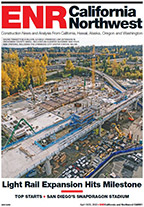Construction spending slipped 0.8% in May from the previous month’s level, to an annual rate of $1.143.3 trillion, but rose 2.8% from the year-earlier figure, the Commerce Dept. has reported.
The department’s Census Bureau said in a report released on July 1 that nonresidential construction put in place in May was down 1.3% from April, to a $684.9-billion seasonally adjusted annual rate. But the total moved up 1.2% from May 2015.
Residential construction was roughly flat in May, month to month, to a rate of $458.3 billion, but it climbed 5.3% from the year-earlier level, the Census Bureau said.
Ken Simonson, Associated General Contractors of America’s chief economist, was generally upbeat about the May numbers and pointed to the 8.2% year-over-year increase in total construction for the first five months of 2016.
Simonson said in a statement that mild winter weather followed by heavy rains in some regions “has probably distorted monthly spending patterns but shouldn’t mask the robust widespread growth in demand for construction so far this year."
At the Associated Builders and Contractors, which monitors nonresidential construction, Chief Economist Anirban Basu noted in a statement that the category’s current inflation-adjusted spending “is essentially unaltered from a year ago.”
He added, “The [nonresidential] industry’s recovery appears to have stalled.” Only five of the 16 nonresidential sectors posted monthly gains in May, including office buildings and health care, each of which was up just 0.2%.
Major nonresidential segments recording downturns included education, off 5.3%; commercial construction, which dipped 1.5%; and highways and streets and power, which were both off 0.2%.
Eight sectors showed year-over-year increases, led by lodging, up 19.5%; and offices, which jumped 17.1%.
Water supply had the largest percentage drop from May 2015, with a 10.1% decrease.
Basu observed that softness in the energy sector is one factor behind the results, but added, “A lack of aggressive public-sector spending is also contributing to the industry’s recent malaise and the outlook for 2017 and 2018 remains decidedly murky.
Still, he said, “Construction remains one of the economy’s busier segments, with many contractors continuing to report lengthy backlog and steady-to-expanding profit margins.
The Census Bureau also reported that private-sector construction put in place in May edged down 0.3% from April to a seasonally adjusted rate $859.3-billion rate. But the segment was up 4.7% compared with May 2015 and increased 9.6% for the January-May period versus the same span last year.
Public construction declined 2.3% in May and 2.6%, year over year, to a $284-billion rate, the bureau said. But it also reported that the category rose 3.8% year to date.




Post a comment to this article
Report Abusive Comment